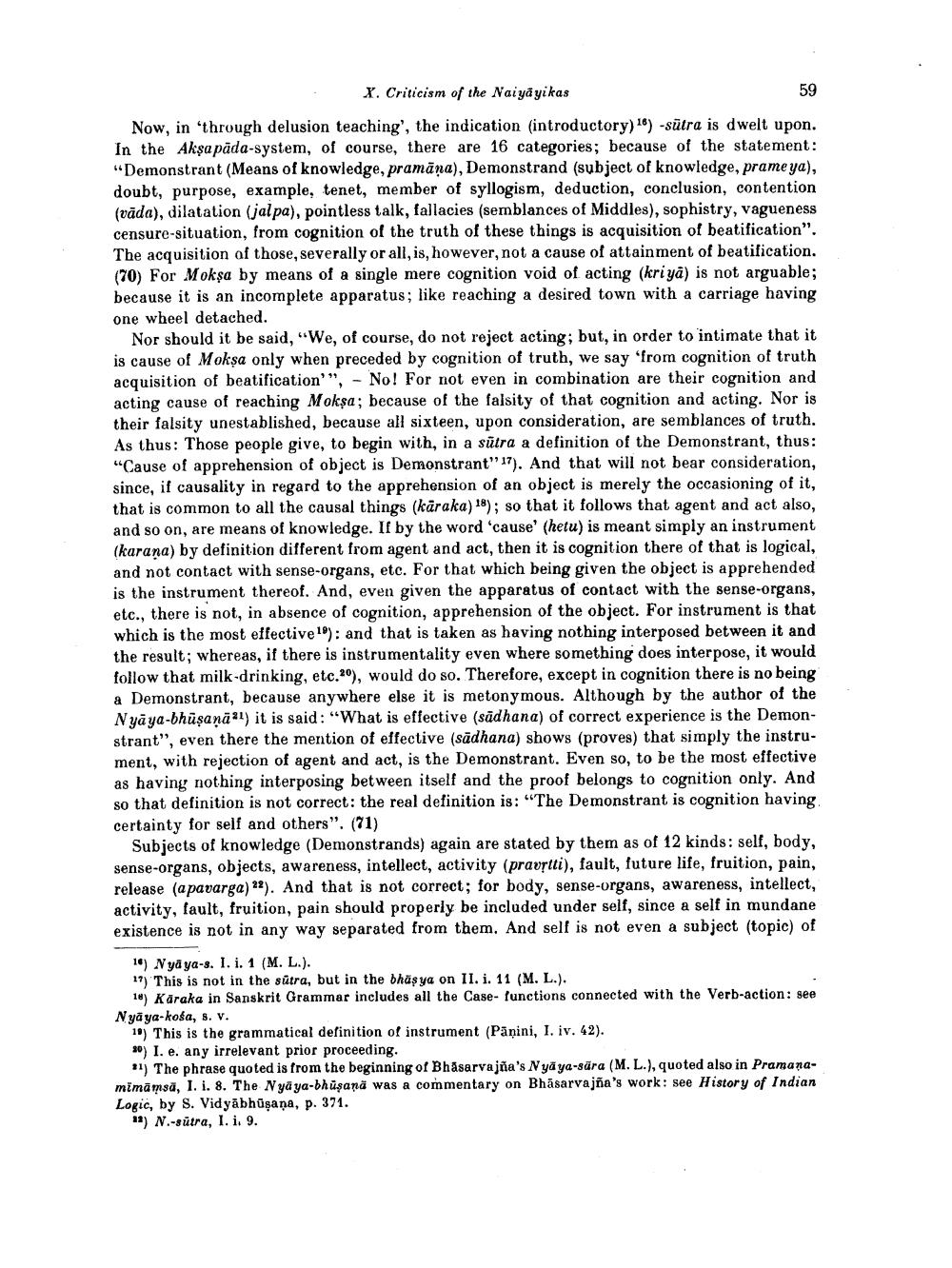________________
59
X. Criticism of the Naiyayikas
Now, in 'through delusion teaching', the indication (introductory) 16) -sutra is dwelt upon. In the Akṣapada-system, of course, there are 16 categories; because of the statement: "Demonstrant (Means of knowledge, pramāna), Demonstrand (subject of knowledge, prame ya), doubt, purpose, example, tenet, member of syllogism, deduction, conclusion, contention (rada), dilatation (jalpa), pointless talk, fallacies (semblances of Middles), sophistry, vagueness censure-situation, from cognition of the truth of these things is acquisition of beatification". The acquisition of those, severally or all, is, however, not a cause of attainment of beatification. (70) For Moksa by means of a single mere cognition void of acting (kriya) is not arguable; because it is an incomplete apparatus; like reaching a desired town with a carriage having one wheel detached.
Nor should it be said, "We, of course, do not reject acting; but, in order to intimate that it is cause of Mokṣa only when preceded by cognition of truth, we say 'from cognition of truth acquisition of beatification"", - No! For not even in combination are their cognition and acting cause of reaching Moksa; because of the falsity of that cognition and acting. Nor is their falsity unestablished, because all sixteen, upon consideration, are semblances of truth. As thus: Those people give, to begin with, in a sutra a definition of the Demonstrant, thus: "Cause of apprehension of object is Demonstrant"17). And that will not bear consideration, since, if causality in regard to the apprehension of an object is merely the occasioning of it, that is common to all the causal things (karaka) 18); so that it follows that agent and act also, and so on, are means of knowledge. If by the word 'cause' (hetu) is meant simply an instrument (karana) by definition different from agent and act, then it is cognition there of that is logical, and not contact with sense-organs, etc. For that which being given the object is apprehended is the instrument thereof. And, even given the apparatus of contact with the sense-organs, etc., there is not, in absence of cognition, apprehension of the object. For instrument is that which is the most effective 19): and that is taken as having nothing interposed between it and the result; whereas, if there is instrumentality even where something does interpose, it would follow that milk-drinking, etc.20), would do so. Therefore, except in cognition there is no being a Demonstrant, because anywhere else it is metonymous. Although by the author of the Nyaya-bhūṣaṇā21) it is said: "What is effective (sadhana) of correct experience is the Demonstrant", even there the mention of effective (sadhana) shows (proves) that simply the instrument, with rejection of agent and act, is the Demonstrant. Even so, to be the most effective as having nothing interposing between itself and the proof belongs to cognition only. And so that definition is not correct: the real definition is: "The Demonstrant is cognition having certainty for self and others". (71)
Subjects of knowledge (Demonstrands) again are stated by them as of 12 kinds: self, body, sense-organs, objects, awareness, intellect, activity (pravṛtti), fault, future life, fruition, pain, release (apavarga) 22). And that is not correct; for body, sense-organs, awareness, intellect, activity, fault, fruition, pain should properly be included under self, since a self in mundane existence is not in any way separated from them. And self is not even a subject (topic) of
1) Nyaya-s. I. i. 1 (M. L.).
17) This is not in the sutra, but in the bhasya on II. i. 11 (M. L.).
18) Käraka in Sanskrit Grammar includes all the Case- functions connected with the Verb-action: see Nyaya-kosa, s. v.
1) This is the grammatical definition of instrument (Panini, I. iv. 42).
30) I. e. any irrelevant prior proceeding.
1) The phrase quoted is from the beginning of Bhasarvajña's Nyaya-sära (M. L.), quoted also in Pramanamimämsä, I. i. 8. The Nyaya-bhüşana was a commentary on Bhasarvajña's work: see History of Indian Logic, by S. Vidyabhūṣaṇa, p. 371.
1) N.-sutra, I. i. 9.




